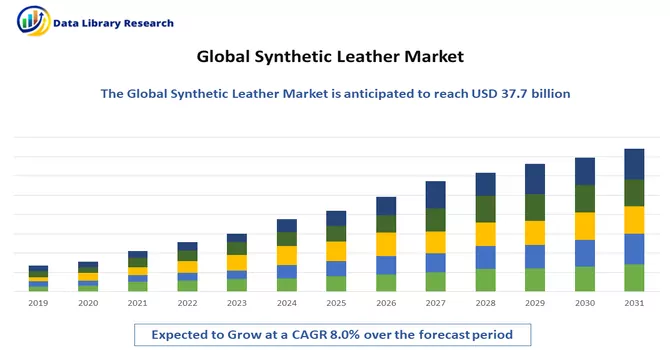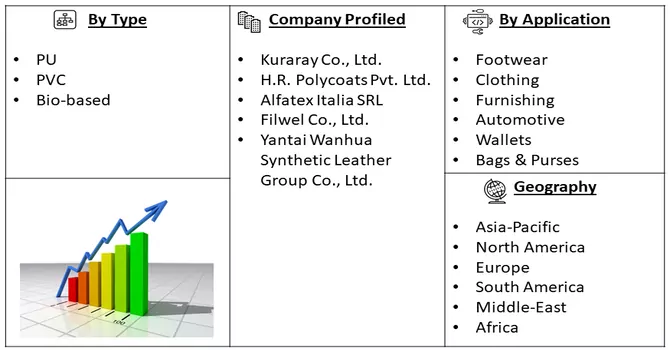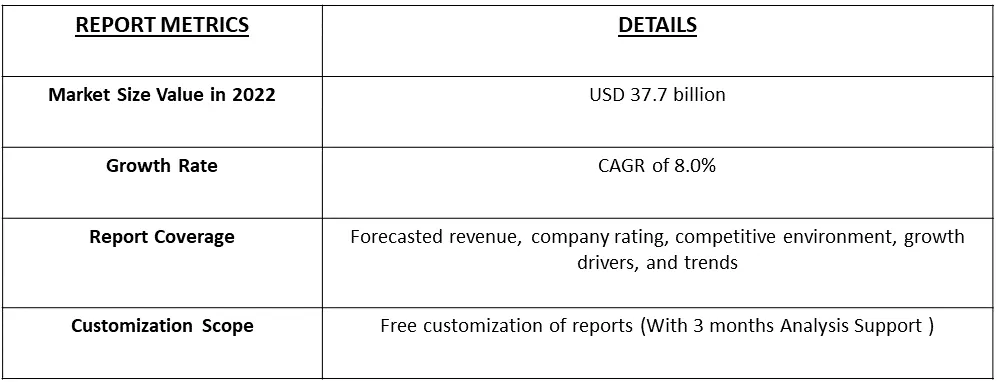In 2022, the global synthetic leather market achieved a valuation of USD 37.7 billion, and it is anticipated to exhibit a compound annual growth rate (CAGR) of 8.0% from 2023 to 2030.

Get Complete Analysis Of The Report - Download Free Sample PDF
A significant driver of this growth is the burgeoning demand from the footwear sector on a global scale. The increased cost of natural leather has further intensified the market's need for viable alternatives. Notably, PVC leather, a crucial type of synthetic leather, has gained widespread popularity owing to its versatility in applications such as shopping bags, cosmetic bags, wallets, suitcases, purses, and travel bags.
Synthetic leather, also known as artificial leather, faux leather, or imitation leather, is a man-made material designed to mimic the appearance and, to some extent, the feel of genuine leather. It is produced using various synthetic substances rather than being derived from animal hides, as is the case with real leather. Synthetic leather serves as a more ethical and often more cost-effective alternative to natural leather. Common materials used in the production of synthetic leather include polyurethane (PU) and polyvinyl chloride (PVC), among others.
There is a rising preference for synthetic leather products made from sustainable and eco-friendly materials. Consumers are increasingly conscious of the environmental impact, prompting manufacturers to explore greener alternatives and production processes. Furthermore, ongoing advancements in manufacturing technologies are influencing the quality and performance of synthetic leather. Innovations such as water-based polyurethane coatings and improved embossing techniques contribute to enhanced durability, texture, and appearance.
Market Segmentation: The Synthetic Leather Market Size, Share & Trends Analysis Report By Type (PU, PVC, Bio-based), By Application (Footwear, Clothing, Furnishing, Automotive, Wallets, Bags & Purses), and Geography (North America, South America, Europe, Asia-Pacific, and Middle-East And Africa). The report provides the market sizes and forecasts in terms of value in USD billion.

For Detailed Market Segmentation - Download Free Sample PDF
Market Drivers:
Growing demand from the footwear industry
The increase in demand for synthetic leather, particularly in the footwear industry, is a key driver of the market in Japan. Synthetic leather is favored in footwear manufacturing for its exceptional durability. The growth in the utilization of artificial and synthetic leather in crafting sports shoes, slippers, casual shoes, sandals, sneakers, flip flops, and rubber clogs is propelling the expansion of the synthetic leather market. Moreover, leading footwear companies are incorporating bio-based synthetic leather for manufacturing luxury footwear in order to stay ahead of the curve and meet rising demand. For instance, Gucci, launched a new line of footwear made from bio-based synthetic leather derived from wood pulp in June 2021. Thus, the market is expected to witness significant growth over the forecast period
Advantages over pure leather
Synthetic leather is preferred over real leather as it is waterproof and cannot be easily damaged by other elements. It is also cost-effective, durable, and more reliable owing to which it is widely used in several industries, where cost reduction is the main target during production. Pure leather is a non-biodegradable product that can linger in the environment for a long period of time. The shift toward sustainable practices and growing environmental concerns are expected to drive synthetic leather growth. Synthetic leather, also known as vegan leather, is an excellent substitute for genuine leather. People are becoming more aware of how pure leather is extracted and are shifting to the use of synthetic leather. Synthetic leather is frequently used in vegan fashion and shoes, which cater to people who care about animal welfare and oppose animal cruelty. Thus, the market is expected to witness significant growth over the forecast period
Market Restraints:
Harmful Effects Of PU And PVC And Environmental Concerns Associated With These Materials
Synthetic leather raw materials such as polyurethane (PU) and polyvinyl chloride (PVC) are hazardous to human and animal health as well as the environment. PU is not biodegradable, contributing to environmental concerns. Items made of PU, such as synthetic leather, can persist in landfills for an extended period, adding to the issue of plastic waste. PU is an isocyanate that can cause asthma attacks and lung irritation, making it potentially harmful to the lungs. It irritates the skin and, due to a lung infection, makes breathing difficult. Polyurethane fumes are frequently inhaled by workers in PU manufacturing plants, causing nausea, vomiting, and dizziness. Thus, the growth of the market is expected to slow down over the forecast period.
The global synthetic leather market, like many other industries, has experienced significant impacts due to the COVID-19 pandemic. The pandemic led to disruptions in global supply chains, affecting the production and distribution of synthetic leather. Lockdowns, restrictions on movement, and temporary closures of manufacturing facilities resulted in delays and shortages of raw materials, impacting the overall supply chain efficiency. The economic uncertainties and reduced consumer confidence during the pandemic resulted in decreased spending on non-essential goods, including fashion and accessories. This decline in consumer purchasing power directly affected the demand for synthetic leather products, especially in the fashion and automotive sectors. The market may witness adaptations and innovations to align with post-pandemic consumer preferences and evolving industry trends. The ability to navigate these challenges and capitalize on emerging opportunities will be crucial for the synthetic leather industry's resilience and growth in the post-COVID-19 era.
Segmental Analysis:
Polyurethane (PU) Types is Expected to Witness Significant Growth Over the Forecast Period
Polyurethane Leather is used for a variety of applications such as footwear, furnishing, automotive, clothing, bags and wallets and many more owing to its properties like it can be made into a variety of colors as well as styles, it doesn’t absorb water which makes it easy to clean, it is flexible like leather, and it doesn’t dry out over the time. The base material of synthetic leather is typically a fabric such as polyester or cotton, which is then coated with a layer of polyurethane. This coating gives the fabric the appearance and texture of genuine leather. The advantages offered by polyurethane are: There are various factors that are leading to the growth of PU leather. Manufacturing of PU Leather involves easier and time-effective processes which results to its low-costs as compared to the genuine leather. PU leather has more pores on its surface which offers breathability in wearable clothing items. Since its manufacturing requires fewer resources, it is better for sustainability and is considered as vegan which prevents cruelty to animals. Also, PU leather is generally easier to clean and maintain compared to natural leather, as it is less prone to staining and can be wiped clean with a damp cloth and manufacturers may produce eco-friendly PU leather by incorporating sustainable practices and materials, such as water-based PU coatings or recycled polyester fabrics. Thus, owing to such advantages, the segment is expected to witness significant growth over the forecast period.
Footwear Segment is Expected to Witness Significant Growth Over the Forecast Period
Synthetic Leather is used in the manufacturing of footwear which makes them comfortable, durable and breathable to stand all day with the appearance of leather. Furthermore, the footwear made up of synthetic leather caters to those who are concerned about the welfare of animals and are more environment friendly since their manufacturing requires less chemical treatment. The following are the advantages offered by synthetic leather in footwear segment: The Footwear fabricated from synthetic leather is very inexpensive, durable and lasts a long time. Moreover, such footwear can withstand scratches and scrapes unlike genuine leather and is not susceptible to crack or peel like leather, these are the factors which are increasing their demand in the market. Moreover, synthetic leathers are designed to be more environmentally friendly, using recycled materials or eco-friendly manufacturing processes as compared to traditional leather, as a result, the use of synthetic leather in making footwear is significantly increasing over the forecast period
Asia-Pacific Region is Expected to Witness Significant Growth Over the Forecast Period
In recent times, the consumption of synthetic leather in the Asia-Pacific market has experienced a noteworthy surge. The demand for synthetic leather in the Asia-Pacific has witnessed a substantial uptick, and this trend is anticipated to continue in the coming years. A significant driver for this growth is the increasing demand for automotive synthetic leather upholstery, which is expected to contribute to heightened consumption levels in the foreseeable future. Initiatives aimed at reinforcing the supply chain during the forecast period are projected to positively impact the overall synthetic leather market in the U.S. The Asia-Pacific region, characterized by high population growth and the development of innovative technology, is poised to emerge as a prime investment destination for the synthetic leather industry. With China standing as the largest leather-producing country globally, its abundance of raw materials significantly contributes to its major share in the regional market. In India, the leather industry holds a noteworthy position, constituting around 13% of the world's leather production. Tamil Nadu, as the leading leather-producing state, contributes over 40% to the country's total production.
The sustainability initiative within the leather and footwear sector, coupled with the rise of vegan leather as a cruelty-free alternative, is anticipated to propel market growth in India. This trend aligns with global efforts towards more sustainable and ethical practices in the leather industry. India, contributing over 9% to the world's footwear production, is experiencing an increased demand for leather. In 2021, India exported leather, footwear, and leather products amounting to more than US $47.92 billion. Key markets for Indian leather and leather products include the United States (18%), Germany (12%), the United Arab Emirates (3.35%), and Poland (2.11%). Thus, the region is expected to witness significant growth over the forecast period.

Get Complete Analysis Of The Report - Download Free Sample PDF
A small number of companies, primarily based in the Asia Pacific region, exert significant dominance over the synthetic leather market. These industry leaders leverage strategic initiatives such as joint ventures, mergers and acquisitions, capacity expansions, and continuous product innovation to propel their revenue growth and fortify their market positions. For example, Winner Nippon Leatherette Pvt. Ltd. consistently engages in the creation of alternatives to authentic leather across diverse applications. Noteworthy participants in the global synthetic leather market encompass. Some prominent players in the global synthetic leather market include:
Recent Development:
1) In May 2022, Converse Japan is reuniting with local brand beautiful people for its second collaborative collection. The duo first connected in early 2022, seeing the rising label transform the All-Star with premium materials and chunky soles.
2) In March 2021, Stahl Holdings BV introduced Stahlite systems based on specialty polymers to produce lightweight automotive leathers. The use of Stahlite reduces the weight of synthetic leather up to 30% compared to traditional leather material.
Q1. What was the Synthetic Leather Market size in 2022?
As per Data Library Research the synthetic leather market achieved a valuation of USD 37.7 billion in 2022.
Q2. At what CAGR is the Synthetic Leather Market projected to grow within the forecast period?
Synthetic Leather Market it is anticipated to exhibit a compound annual growth rate (CAGR) of 8.0% over the forecast period.
Q3. Which Region is expected to hold the highest Market share?
Asia-pacific region is expected to hold the highest Market share.
Q4. What are the Growth Drivers of the Synthetic Leather Market?
Growing demand from the footwear industry and Advantages over pure leather are the Growth Drivers of the Synthetic Leather Market.
Data Library Research are conducted by industry experts who offer insight on industry structure, market segmentations technology assessment and competitive landscape (CL), and penetration, as well as on emerging trends. Their analysis is based on primary interviews (~ 80%) and secondary research (~ 20%) as well as years of professional expertise in their respective industries. Adding to this, by analysing historical trends and current market positions, our analysts predict where the market will be headed for the next five years. Furthermore, the varying trends of segment & categories geographically presented are also studied and the estimated based on the primary & secondary research.
In this particular report from the supply side Data Library Research has conducted primary surveys (interviews) with the key level executives (VP, CEO’s, Marketing Director, Business Development Manager and SOFT) of the companies that active & prominent as well as the midsized organization
FIGURE 1: DLR RESEARH PROCESS

Extensive primary research was conducted to gain a deeper insight of the market and industry performance. The analysis is based on both primary and secondary research as well as years of professional expertise in the respective industries.
In addition to analysing current and historical trends, our analysts predict where the market is headed over the next five years.
It varies by segment for these categories geographically presented in the list of market tables. Speaking about this particular report we have conducted primary surveys (interviews) with the key level executives (VP, CEO’s, Marketing Director, Business Development Manager and many more) of the major players active in the market.
Secondary ResearchSecondary research was mainly used to collect and identify information useful for the extensive, technical, market-oriented, and Friend’s study of the Global Extra Neutral Alcohol. It was also used to obtain key information about major players, market classification and segmentation according to the industry trends, geographical markets, and developments related to the market and technology perspectives. For this study, analysts have gathered information from various credible sources, such as annual reports, sec filings, journals, white papers, SOFT presentations, and company web sites.
Market Size EstimationBoth, top-down and bottom-up approaches were used to estimate and validate the size of the Global market and to estimate the size of various other dependent submarkets in the overall Extra Neutral Alcohol. The key players in the market were identified through secondary research and their market contributions in the respective geographies were determined through primary and secondary research.
Forecast Model
